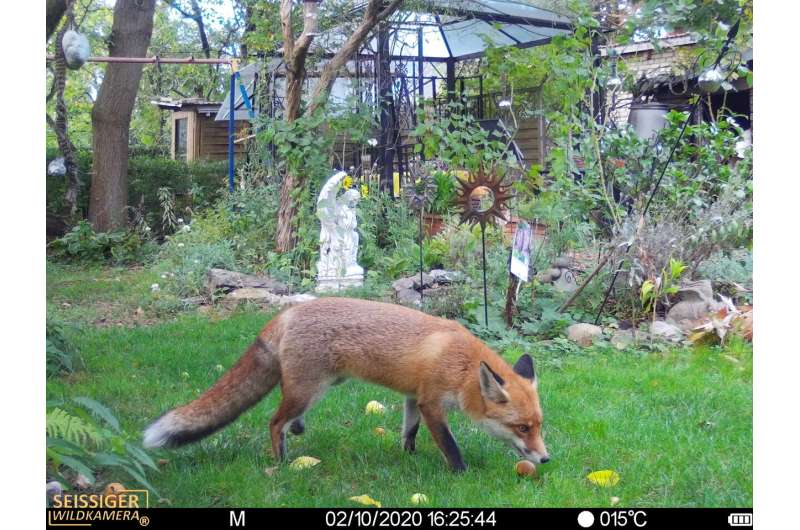Foxes, racoons, stone martens and domestic cats got along in Berlin before and during COVID lockdowns

Avoid or compete, eat or be eaten, exploit or cooperate—biotic communities are shaped by species interactions in many different ways. Urban environments represent a special case as human presence and influence may have fundamentally changed the rules of the game. Around 150 wildlife cameras installed by Berlin citizen scientists in their gardens in five rounds from autumn 2018 to autumn 2020 produced tens of thousands of photographs. Their analysis by a team of scientists from the Leibniz Institute for Zoo and Wildlife Research (Leibniz-IZW) sheds light on how foxes, racoons, martens and cats get along with people and with each other in the city: All three wild species used the same localities, but with little temporal overlap during the night. All wild species avoided domestic cats. And during lockdowns they were more often recorded, especially at night. These and more insights are published in a recent article in the Journal of Animal Ecology.
The analysis of the photographs is part of the citizen science project "Wildlife Researchers" at the Leibniz-IZW led by Stephanie Kramer-Schadt, one pillar of the science-to-society interface project WTimpact funded by the German Federal Ministry of Education and Research from 2017 to 2021. In the Wildlife Researcher project, professional scientists and Berlin citizens joined forces to investigate the ecology of urban wildlife. Gardens were chosen as study sites because they both attract and discourage wildlife by acting as a food supply with composts, crops or pet food leftovers, and are places of close encounters with people or domestic cats.
The project team divided the city of Berlin into a regular grid of almost 300 cells of two by two kilometers each. During five periods, lasting one month each, Berlin citizens with a private garden could apply and were chosen to produce an even distribution across the grid. Participating citizen scientists installed a wildlife camera in their garden, which photographed animals when the motion sensor of the camera detected movements. Scientists later combined these data with local information on gardens such as garden size, local tree cover, potential food sources and height of the fence as well as other information such as population density. In each sampling period the cameras recorded between 2200 and 3000 cat photos, 300 to 1200 red fox photos, 250 to 1000 raccoon photos and 50 to 300 stone marten photos, along with many photos of other mammals.
"What we were interested in is whether and how the flexible and adaptive carnivore species interacted spatially and temporally in human-dominated environments," says first author Dr. Julie Louvrier, IPODI fellow at Technical University of Berlin and visiting scientist at the Leibniz-IZW Department of Ecological Dynamics. "This means we wanted to know whether they use the same places, and if so, whether they avoid each other by coming at different times of day or night, for example."
These are the main findings of Louvrier and her colleagues:
- The seasons and the COVID lockdown greatly influenced how often the species were recorded. Autumn is a much livelier season for Berlin's foxes, racoons, martens and cats than spring. During the lockdown Berliners presumably used their gardens more often during the day, forcing wildlife to be more nocturnal. At the same time, overall presence of foxes, martens and racoons in gardens increased during lockdowns, most likely because of an overall decreased presence of people in the urban space.
- Although all wild carnivore species are used to human presence to some extent, they avoided human encounters by concentrating their movements during the night, the period during which people are the least active.
- The presence of foxes, racoons and martens changed in a similar manner, meaning that more foxes were an indicator of more racoons and martens and vice versa. They belong to the same foraging guild and use the same resources in a human-dominated environment such as the urban landscape. At the same time, the species avoid each other at small temporal scales: There was a delay between consecutive detections of the different species, indicating a temporal segregation of the same space.
- Domestic cats are a special case: On the one hand, more cat presence meant more records of racoons (the racoons probably use the presence of cats as a proxy for pet food); on the other hand, stone martens and foxes were not more likely to show up when cats were present. This indicates a hierarchy of the four species, with the human-related pet species being the dominant one. This is especially true in the light of another interesting observation: Cats do not seem to avoid the others whatever the time of day, although their body mass, often thought to be a proxy for dominance, is usually less than that of foxes and racoons.
"We humans impose strong selective forces on wildlife species, thereby changing their behavior and way of living. The lockdowns were a blessing in disguise, like an experiment, providing an opportunity to study what our wild neighbors do when people are suddenly absent from urban space, and we are extremely grateful to all citizen scientists who participated in our unique investigation," Stephanie Kramer-Schadt says.
"Our investigation sheds light on the rules underlying interactions in a community of medium-sized carnivores in an urban environment," says Louvrier. There are several factors that influence these interaction patterns both spatially and temporally, especially when considering the effect of human presence. People play the role of a "hyper-keystone" species and their pets exert dominance over local wildlife, even over species that are relatively well adjusted to human-dominated landscapes.
More information: Julie L. P. Louvrier et al, Spatiotemporal interactions of a novel mesocarnivore community in an urban environment before and during SARS‐CoV‐2 lockdown, Journal of Animal Ecology (2021). DOI: 10.1111/1365-2656.13635
Journal information: Journal of Animal Ecology
Provided by Forschungsverbund Berlin e.V. (FVB)




















